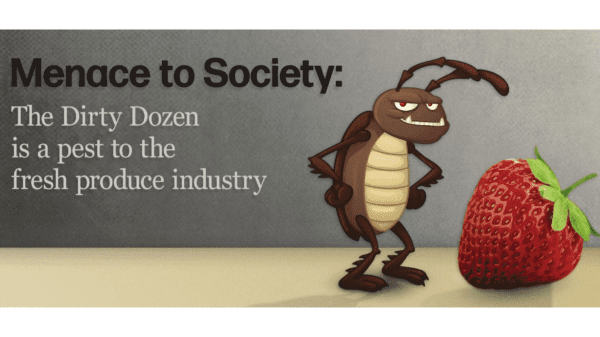
According to the FDA’s 2019 report for its Pesticide Residue Monitoring Program, released in November 2021, “98.7 percent of domestic and 89.1 percent of import foods were compliant with federal standards. No pesticide chemical residues were found in 42.4 percent of the domestic and 49.4 percent of the import samples.”
For domestic fruits, of 389 samples tested, only one (0.3 percent) contained “violative residues,” according to the FDA, meaning 99.7 percent were within safety guidelines. No residues at all were found in 12.6 percent of samples.
For domestic vegetables, violative residues were found in 2.2 percent of the 506 samples tested, meaning 97.8 percent were in compliance. No residues at all were detected in 41.9 percent of the samples.
Violation rates for imported produce were significantly higher: 8.4 percent of fruits and 12 percent of vegetables were found to be in violation of the EPA standards.
The import commodity tested with by far the highest percentage of violations was dasheen taro, of which 77.8 percent of samples were in violation. Imports of this vegetable come largely from Mexico and Latin America.
Other imported produce commodities with high levels of violation, according to the FDA report, are nectarines, with 42.9 percent in violation, prickly pear (40.0 percent), cilantro (31.0 percent), spinach (27.8 percent), string beans (25 percent), and dragon fruit (26.3 percent).
Comparing apples to oranges
Curiously, this list bears little resemblance to the 2021 Dirty Dozen, as the only commodity to appear on both lists was nectarines.
“Just because the levels of pesticides detected on produce may be below the legal limits set by EPA doesn’t mean they are safe,” counters Alex Formuzis, senior vice president of communications and strategic campaigns for the Environmental Working Group.
“One of the reasons for their attacks on the Shopper’s Guide is the fact that the organic industry’s annual sales are consistently in the double digits, while conventional sales have not enjoyed the same steady and robust growth.”
Formuzis’ claim about consistent double-digit growth for organic produce is not strictly correct.
According to 2021 Organic Produce Performance Report released by the Organic Produce Network, organic fresh produce sales grew by 5.5 percent in 2021 versus 14.5 percent in 2020, with year-over-year growth at 2 percent. Overall, organic produce accounts for 12 percent of the market, with conventional at 88 percent.
This an excerpt from the cover story in the May/June 2022 issue of Produce Blueprints Magazine. Click here to read the whole issue.
According to the FDA’s 2019 report for its Pesticide Residue Monitoring Program, released in November 2021, “98.7 percent of domestic and 89.1 percent of import foods were compliant with federal standards. No pesticide chemical residues were found in 42.4 percent of the domestic and 49.4 percent of the import samples.”
For domestic fruits, of 389 samples tested, only one (0.3 percent) contained “violative residues,” according to the FDA, meaning 99.7 percent were within safety guidelines. No residues at all were found in 12.6 percent of samples.
For domestic vegetables, violative residues were found in 2.2 percent of the 506 samples tested, meaning 97.8 percent were in compliance. No residues at all were detected in 41.9 percent of the samples.
Violation rates for imported produce were significantly higher: 8.4 percent of fruits and 12 percent of vegetables were found to be in violation of the EPA standards.
The import commodity tested with by far the highest percentage of violations was dasheen taro, of which 77.8 percent of samples were in violation. Imports of this vegetable come largely from Mexico and Latin America.
Other imported produce commodities with high levels of violation, according to the FDA report, are nectarines, with 42.9 percent in violation, prickly pear (40.0 percent), cilantro (31.0 percent), spinach (27.8 percent), string beans (25 percent), and dragon fruit (26.3 percent).
Comparing apples to oranges
Curiously, this list bears little resemblance to the 2021 Dirty Dozen, as the only commodity to appear on both lists was nectarines.
“Just because the levels of pesticides detected on produce may be below the legal limits set by EPA doesn’t mean they are safe,” counters Alex Formuzis, senior vice president of communications and strategic campaigns for the Environmental Working Group.
“One of the reasons for their attacks on the Shopper’s Guide is the fact that the organic industry’s annual sales are consistently in the double digits, while conventional sales have not enjoyed the same steady and robust growth.”
Formuzis’ claim about consistent double-digit growth for organic produce is not strictly correct.
According to 2021 Organic Produce Performance Report released by the Organic Produce Network, organic fresh produce sales grew by 5.5 percent in 2021 versus 14.5 percent in 2020, with year-over-year growth at 2 percent. Overall, organic produce accounts for 12 percent of the market, with conventional at 88 percent.
This an excerpt from the cover story in the May/June 2022 issue of Produce Blueprints Magazine. Click here to read the whole issue.
Richard Smoley, contributing editor for Blue Book Services, Inc., has more than 40 years of experience in magazine writing and editing, and is the former managing editor of California Farmer magazine. A graduate of Harvard and Oxford universities, he has published 12 books.



